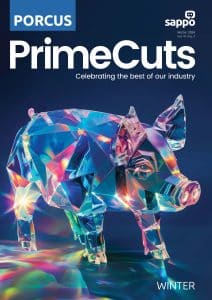Source: BFAP/SAPPO, photo credit: The Black Peppercorn
Although pork is one of the most popular meat types worldwide, in South Africa only 8% of the meat consumed is pork compared to 66% chicken, 22% beef and 4% lamb. The low pork consumption can be attributed to many factors such as low-income elasticity where most pork consumption is in the middle and upper income groups.
Pork consumption is also affected by consumer perceptions of the product as well as religious groupings who abstain from eating pork; although the latter constitutes less than 20% of the population. This means that there is ample room for growth in the other 80% if negative perceptions can be overcome. It is critical, however, to understand consumer preferences. This first phase report aims to explain consumption and procurement preferences based on product flows through abattoirs.
The livestock sector contributed on average almost half (47%) of the gross agricultural production value between 2018 and 2020. Within the livestock sector poultry contributed 34% followed by beef (26%), mutton (5%), pork (2%) and goat (1%) when considering the formal market. Despite its small size the pork industry has been growing at an average rate of 9% per annum for the last 10 years. However, pork consumption remains low compared to the other meat types. While per capita poultry consumption was on average 35.5 kg from 2018 to 2020, beef was 12.6 kg, pork 4.3 kg and mutton 2.0 kg.
Much less is known about the informal value chain which has also developed during the same period. When comparing statistics on the number of households that were engaged in pig farming in 2011 compared to 2016, there was an 87% increase implying an average annual growth of 22%.
A study in KwaZulu-Natal found that 63% households kept pigs for home consumption, 33% as a source of income and 3% for manure. Of the households indicating pigs as a source of income, 76% sold live pigs while SAPPO found in a separate study that half of small-scale farmers also sell pigs to abattoirs. BFAP estimated that informal production amounted to 26 600 tons of pork in 2016 meaning that the informal herd has an asset value of about R1.24 billion and provides affordable protein to rural areas.
There is a need to understand the flow of pork throughout the value chain. This first phase of the study focussed on the flow through the abattoir by investigating sourcing practices and the flow of products from the abattoir. Data for this study were collected by informal interviews with 50 abattoirs of which 12 are among the top 20 in terms of slaughter volumes. Of these participants 50% slaughter between 0 and 999 pigs per month, 26% between 1000 and 4999, 16% between 5000 and 9999 while 8% slaughter more than 10000 pigs per month.
Sourcing of animals for slaughter is guided by biosecurity and food safety, as well as throughput numbers to optimise fixed costs. Abattoirs consequently employ a so-called “low-risk” approach with contracting the preferred method (71%) of procurement. Some abattoirs (28%) have producers as shareholders who deliver to them.
Only 2% of the respondents (slaughtering less than 1000 pigs per month) indicated that they source from non-contracted producers including smallholder farmers. Abattoirs slaughtering more than 5000 animals per month often source from Pork 360 approved producers to ensure guaranteed biosecurity standards. This is beneficial for increased consumer confidence and risk management but makes it more difficult for small-scale producers to penetrate the formal value chain. The bigger abattoirs (>10 000 per month) also have up to 60% of their slaughtering from their own piggeries or that of their shareholders, the rest being from contracted producers.
Products sold by the participating abattoirs comprise either whole carcasses or primal cuts of which 36% go to processors, 27% to wholesalers and 26% to retailers, butcheries and the hospitality sector. Only 4% is sold directly to the public including informal traders, 4% is marketed through their own outlets and 3% is exported while 1% is not marketed, such as pigs slaughtered for clients. It is therefore difficult to measure what share of the product reaches townships and informal markets.
Changing perceptions of pork and cheaper prices recently led to an increase in pork consumption. Pork sold for about 45% less than beef during the last five years and 65% less than mutton. Participants noted that one reason for increased consumption is related to changes in pork preparation resulting from marketing campaigns. BFAP predicts that meat consumption during the next decade will grow by 12% for beef, 13% for chicken and 21% for pork while mutton consumption will decrease by 12%.
In conclusion, to initiate the predicted growth, pork consumption amongst lower income consumers will have to be stimulated. They often buy from the informal sector which is not well understood and needs to be studied. Since this study was conducted at the abattoir level producing carcasses and wholesale cuts, it implies that further investigation with a focus on wholesale meat distribution, as well as formal and informal retail is required to understand consumption among lower income consumers. Along with consumption trends, it is also important to develop small scale production practices which will improve consumer perceptions and meat preferences.
The South African Pork Producers’ Organisation (SAPPO) coordinates industry interventions and collaboratively manages risks in the value chain to enable the sustainability and profitability of pork producers in South Africa.









